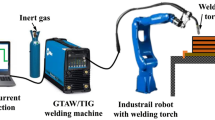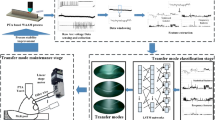Abstract
Wire-arc additive manufacturing (WAAM) is an arc-based directed energy deposition approach that uses an electrical arc as a source of fusion to melt the wire feedstock and deposit layer by layer. It’s applicable in fabricating large-scale components. At this stage, there are still some issues that need to be researched deeply, such as manufacturing accuracy control, process parameters optimization, path planning, and online monitoring. Machine learning is a new emerging artificial intelligence technology, which is more and more applied in modern industry. In this study, a machine learning based control algorithm was applied in melt pool width control. To monitor the WAAM process, deep learning algorithms were applied in anomalies recognition. At the same time, machine learning methods were employed to predict the deposited surface roughness during the WAAM process.
Access this chapter
Tax calculation will be finalised at checkout
Purchases are for personal use only
Similar content being viewed by others
References
Xia C, Pan Z, Polden J, Li H, Xu Y, Chen S, Zhang Y (2020) A review on wire arc additive manufacturing: monitoring, control and a framework of automated system. J Manuf Syst 57:31–45
Müller J, Grabowski M, Müller C, Hensel J, Unglaub J, Thiele K, Kloft H, Dilger K (2019) Design and parameter identification of wire and arc additively manufactured (WAAM) steel bars for use in construction. Metals 9(7):725
Taşdemir A, Nohut S (2020) An overview of wire arc additive manufacturing (WAAM) in shipbuilding industry. Ships Offshore Struct 1–18
Sreedhar U, Krishnamurthy CV, Balasubramaniam K, Raghupathy VD, Ravisankar S (2012) Automatic defect identification using thermal image analysis for online weld quality monitoring. J Mater Process Technol 212(7):1557–1566. https://doi.org/10.1016/j.jmatprotec.2012.03.002
Xia C, Pan Z, Zhang S, Li H, Chen S (2020) Model-free adaptive iterative learning control of melt pool width in wire arc additive manufacturing. Int J Adv Manuf Technol 110(7–8):1–12
Wang C, Tan X, Tor S, Lim CJAM (2020) Machine learning in additive manufacturing: state-of-the-art and perspectives, p 101538
Zhang Y, Hong GS, Ye D, Zhu K, Fuh JYH (2018) Extraction and evaluation of melt pool, plume and spatter information for powder-bed fusion AM process monitoring. Mater Des 156:458–469. https://doi.org/10.1016/j.matdes.2018.07.002
Kwon O, Kim HG, Ham MJ, Kim W, Kim G-H, Cho J-H, Kim NI, Kim K (2018) A deep neural network for classification of melt-pool images in metal additive manufacturing. J Intell Manuf. https://doi.org/10.1007/s10845-018-1451-6
Caggiano A, Zhang J, Alfieri V, Caiazzo F, Gao R, Teti R (2019) Machine learning-based image processing for on-line defect recognition in additive manufacturing. CIRP Ann 68(1):451–454
zur Jacobsmühlen J, Kleszczynski S, Witt G, Merhof D (2015) Detection of elevated regions in surface images from laser beam melting processes. In: IECON 2015–41st annual conference of the IEEE industrial electronics society. IEEE
Yu H, Xu Y, Song J, Pu J, Zhao X, Yao G (2015) On-line monitor of hydrogen porosity based on arc spectral information in Al–Mg alloy pulsed gas tungsten arc welding. Opt Laser Technol 70:30–38. https://doi.org/10.1016/j.optlastec.2015.01.010
Ye D, Hong GS, Zhang Y, Zhu K, Fuh JYH (2018) Defect detection in selective laser melting technology by acoustic signals with deep belief networks. Int J Adv Manuf Technol 96(5–8):2791–2801. https://doi.org/10.1007/s00170-018-1728-0
Shevchik SA, Kenel C, Leinenbach C, Wasmer K (2018) Acoustic emission for in situ quality monitoring in additive manufacturing using spectral convolutional neural networks. Addit Manuf 21:598–604. https://doi.org/10.1016/j.addma.2017.11.012
Caiazzo F, Caggiano A (2018) Laser direct metal deposition of 2024 Al alloy: trace geometry prediction via machine learning. Materials (Basel) 11(3). https://doi.org/10.3390/ma11030444
Xiong J, Zhang G, Hu J, Wu L (2014) Bead geometry prediction for robotic GMAW-based rapid manufacturing through a neural network and a second-order regression analysis. J Intell Manuf 25(1):157–163. https://doi.org/10.1007/s10845-012-0682-1
Garg A, Lam JSL, Savalani M (2015) A new computational intelligence approach in formulation of functional relationship of open porosity of the additive manufacturing process. Int J Adv Manuf Technol 80(1–4):555–565
Zhang M, Sun C-N, Zhang X, Goh PC, Wei J, Hardacre D, Li H (2019) High cycle fatigue life prediction of laser additive manufactured stainless steel: a machine learning approach. Int J Fatigue 128:105194
Xu Y, Lv N, Zhong J, Chen H, Chen S (2012) Research on the real-time tracking information of three-dimension welding seam in robotic GTAW process based on composite sensor technology. J Intell Rob Syst 68(2):89–103
Fang J, Wang K (2019) Weld pool image segmentation of hump formation based on fuzzy C-means and Chan-Vese model. J Mater Eng Perform 28(7):4467–4476
Xia C, Pan Z, Zhang S, Polden J, Li H, Xu Y, Chen S (2020) Mask R-CNN-based welding image object detection and dynamic modelling for WAAM. Transactions on intelligent welding manufacturing. Springer, pp 57–73
Lin T-Y, Maire M, Belongie S, Hays J, Perona P, Ramanan D, Dollár P, Zitnick CL (2014) Microsoft coco: common objects in context. In: European conference on computer vision. Springer
Pan SJ, Yang Q (2009) A survey on transfer learning. IEEE Trans Knowl Data Eng 22(10):1345–1359
Ding D, Pan Z, Cuiuri D, Li H (2015) A multi-bead overlapping model for robotic wire and arc additive manufacturing (WAAM). Robot Comput-Integr Manuf 31:101–110. https://doi.org/10.1016/j.rcim.2014.08.008
Xia C, Pan Z, Polden J, Li H, Xu Y, Chen SJJOIM (2021) Modelling and prediction of surface roughness in wire arc additive manufacturing using machine learning, p 1–16
Perez L, Wang J (2017) The effectiveness of data augmentation in image classification using deep learning. arXiv preprint arXiv:1712.04621
Carneiro T, Da Nóbrega RVM, Nepomuceno T, Bian G-B, De Albuquerque VHC, Reboucas Filho PP (2018) Performance analysis of google colaboratory as a tool for accelerating deep learning applications. IEEE Access 6:61677–61685
Xia C, Pan Z, Zhang S, Li H, Xu Y, Chen S (2020) Model-free adaptive iterative learning control of melt pool width in wire arc additive manufacturing. Int J Adv Manuf Technol 110(7):2131–2142
Acknowledgements
The authors gratefully acknowledge the China Scholarship Council for financial support (NO. 201704910782) and UOW Welding and Industrial Automation Research Centre.
Author information
Authors and Affiliations
Corresponding author
Editor information
Editors and Affiliations
Rights and permissions
Copyright information
© 2023 The Author(s), under exclusive license to Springer Nature Singapore Pte Ltd.
About this paper
Cite this paper
Li, Y., Mu, H., Yu, Z., Xia, C., Pan, Z., Li, H. (2023). Machine Learning in Process Monitoring and Control for Wire-Arc Additive Manufacturing. In: Chen, S., Zhang, Y., Feng, Z. (eds) Transactions on Intelligent Welding Manufacturing. RWIA 2020. Transactions on Intelligent Welding Manufacturing. Springer, Singapore. https://doi.org/10.1007/978-981-19-6149-6_2
Download citation
DOI: https://doi.org/10.1007/978-981-19-6149-6_2
Published:
Publisher Name: Springer, Singapore
Print ISBN: 978-981-19-6148-9
Online ISBN: 978-981-19-6149-6
eBook Packages: Intelligent Technologies and RoboticsIntelligent Technologies and Robotics (R0)




